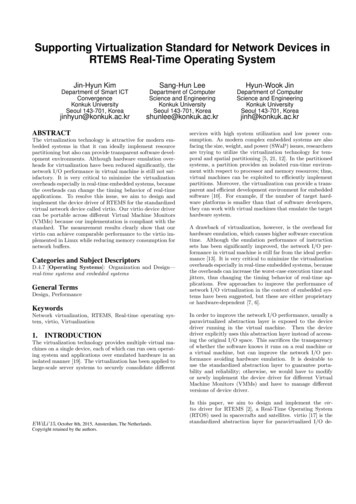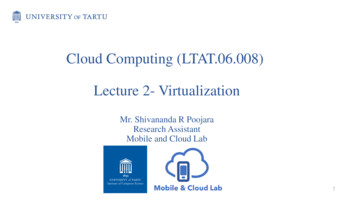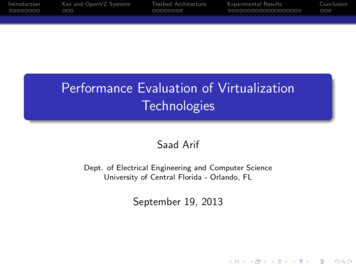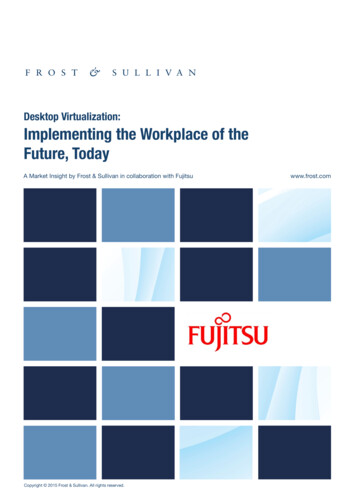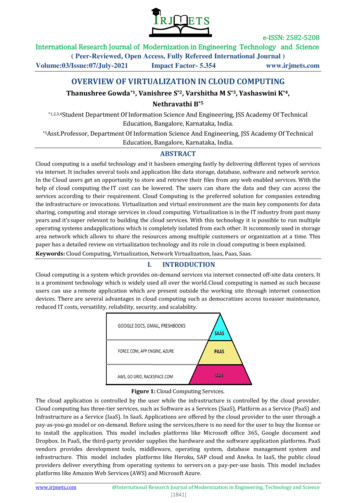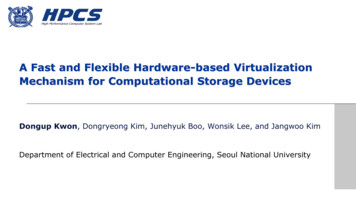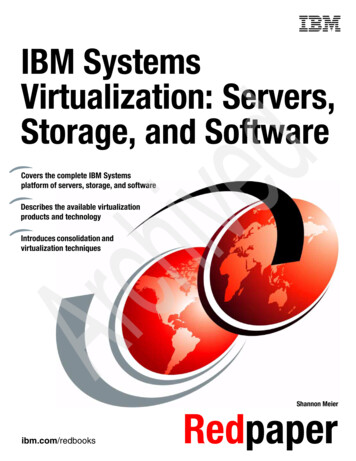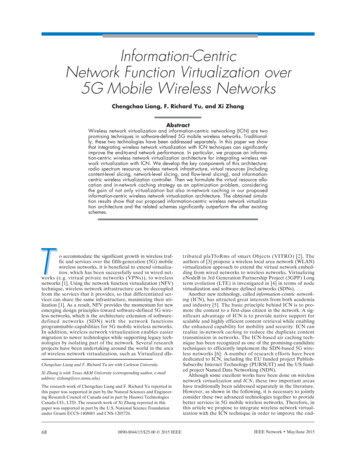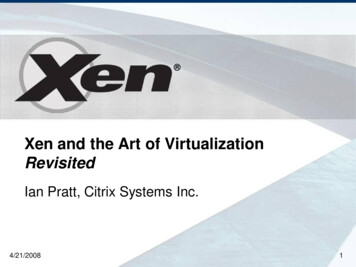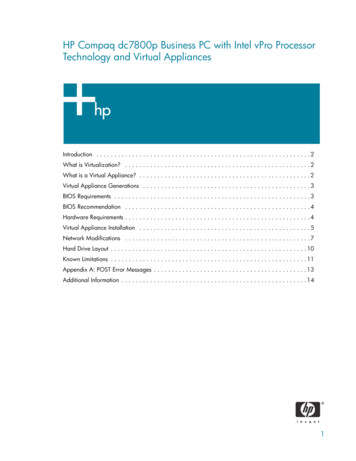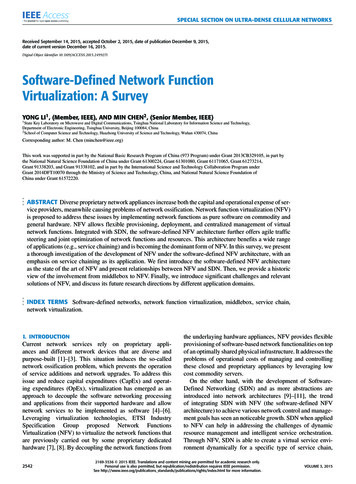
Transcription
SPECIAL SECTION ON ULTRA-DENSE CELLULAR NETWORKSReceived September 14, 2015, accepted October 2, 2015, date of publication December 9, 2015,date of current version December 16, 2015.Digital Object Identifier 10.1109/ACCESS.2015.2499271Software-Defined Network FunctionVirtualization: A SurveyYONG LI1 , (Member, IEEE), AND MIN CHEN2 , (Senior Member, IEEE)1 StateKey Laboratory on Microwave and Digital Communications, Tsinghua National Laboratory for Information Science and Technology,Department of Electronic Engineering, Tsinghua University, Beijing 100084, China2 School of Computer Science and Technology, Huazhong University of Science and Technology, Wuhan 430074, ChinaCorresponding author: M. Chen (minchen@ieee.org)This work was supported in part by the National Basic Research Program of China (973 Program) under Grant 2013CB329105, in part bythe National Natural Science Foundation of China under Grant 61300224, Grant 61301080, Grant 61171065, Grant 61273214,Grant 91338203, and Grant 91338102, and in part by the International Science and Technology Collaboration Program underGrant 2014DFT10070 through the Ministry of Science and Technology, China, and National Natural Science Foundation ofChina under Grant 61572220.ABSTRACT Diverse proprietary network appliances increase both the capital and operational expense of service providers, meanwhile causing problems of network ossification. Network function virtualization (NFV)is proposed to address these issues by implementing network functions as pure software on commodity andgeneral hardware. NFV allows flexible provisioning, deployment, and centralized management of virtualnetwork functions. Integrated with SDN, the software-defined NFV architecture further offers agile trafficsteering and joint optimization of network functions and resources. This architecture benefits a wide rangeof applications (e.g., service chaining) and is becoming the dominant form of NFV. In this survey, we presenta thorough investigation of the development of NFV under the software-defined NFV architecture, with anemphasis on service chaining as its application. We first introduce the software-defined NFV architectureas the state of the art of NFV and present relationships between NFV and SDN. Then, we provide a historicview of the involvement from middlebox to NFV. Finally, we introduce significant challenges and relevantsolutions of NFV, and discuss its future research directions by different application domains.INDEX TERMS Software-defined networks, network function virtualization, middlebox, service chain,network virtualization.I. INTRODUCTIONCurrent network services rely on proprietary appliances and different network devices that are diverse andpurpose-built [1]–[3]. This situation induces the so-callednetwork ossification problem, which prevents the operationof service additions and network upgrades. To address thisissue and reduce capital expenditures (CapEx) and operating expenditures (OpEx), virtualization has emerged as anapproach to decouple the software networking processingand applications from their supported hardware and allownetwork services to be implemented as software [4]–[6].Leveraging virtualization technologies, ETSI IndustrySpecification Group proposed Network FunctionsVirtualization (NFV) to virtualize the network functions thatare previously carried out by some proprietary dedicatedhardware [7], [8]. By decoupling the network functions from2542the underlaying hardware appliances, NFV provides flexibleprovisioning of software-based network functionalities on topof an optimally shared physical infrastructure. It addresses theproblems of operational costs of managing and controllingthese closed and proprietary appliances by leveraging lowcost commodity servers.On the other hand, with the development of SoftwareDefined Networking (SDN) and as more abstractions areintroduced into network architectures [9]–[11], the trendof integrating SDN with NFV (the software-defined NFVarchitecture) to achieve various network control and management goals has seen an noticeable growth. SDN when appliedto NFV can help in addressing the challenges of dynamicresource management and intelligent service orchestration.Through NFV, SDN is able to create a virtual service environment dynamically for a specific type of service chain,2169-3536 2015 IEEE. Translations and content mining are permitted for academic research only.Personal use is also permitted, but republication/redistribution requires IEEE permission.See http://www.ieee.org/publications standards/publications/rights/index.html for more information.VOLUME 3, 2015
Y. Li, M. Chen: Software-Defined NFV: A Surveyconsequently the dedicated hardware and complex labor workto provide a new coming service request is avoid. In conjunction with the use of SDN, NFV further enables real-timeand dynamic function provisioning along with flexible trafficforwarding.Software-defined NFV leverages network virtualizationand logically centralized intelligence to minimize theservice providing cost and maximize the utilization of network resource. In this case, the obtained higher resourceutilization will introduce less investigation on the hardwareequipments, which on the other hand simplifies networkingoperations. Moreover, by automating current manually intensive network configuration, provisioning, and management,the time and operation complexity are significantly reducedand manual errors are dramatically decreased, which offersbetter scalability. On the other hand, especially in largescale networks, deploying and providing a new kinds ofservice usually results in a long and repeated process thatrequires long cycles of validation, verifying, and testing.By automating the control, managing and orchestrationof the NFV related infrastructure, the deploying timeand operation cost for network configuration and operation changes for these new services will be significantlyshortened.Service chaining is the main area that software-definedNFV can play an important role [12], [13]. In the currentnetworks, a service chain include a set of hardware dedicatednetwork appliances offering services such as load balancers,firewall, Deep Packet Inspection (DPI), Intrusion DetectionSystem (IDS), and etc., to support a dedicate networkingprocessing and applications [14]–[16]. When it comes a newservice requirement, new hardware devices must be deployed,installed and connected by some order, which is extremelytime-consuming, complexity, high-cost and error-prone. Thiskind of networking service providing requires dedicate planof networking changes and outages, which on the other handincurs high OPEX. This situation is exacerbated when alot of different kinds of service sequences are dedicated todifferent traffic flows by an operator. On the other hand, thearchitecture of software-defined NFV is able to simplify theservice chain deployment and provisioning. It enables easierand cheaper service providing in the local area network,enterprise networks, data center, and Interent service providernetworks.This survey introduces the state-of-the-art of NFVand its main challenges within the software-definedNFV architecture. Service chaining is highlighted and discussed as a core application of NFV in different contexts.We further provide guidelines for future developments ofNFV in various application scenarios. In Section II, weintroduce the software-defined NFV architecture as the stateof-the-art of NFV and present relationships between NFVand SDN. Then, we provide a historic view of the involvement from middlebox to NFV in Section III. After surveythe current technology of service chain in Section IV, weintroduce significant challenges and relevant solutions ofVOLUME 3, 2015NFV in Section V, and discuss its future research directionsby different application domains in Section VI. Finally, weconclude the paper in Section VII.II. SOFTWARE-DEFINED NETWORKFUNCTION VIRTUALIZATIONTo reduce CapEx and OpEx introduced by diverse proprietaryappliances, NFV was proposed to exploit and take advantageof the virtualization technology. NFV allows network operators and service providers to implement network functions insoftware, leveraging standard servers and virtualization technologies, instead of run on purpose-built hardware. Recenttrends of increased user information demands, explosion oftraffic and diverse service requirements further drive NFVto be integrated with SDN, forming the software-definedNFV architecture. This architecture offers great flexibility,programmability and automation to the operators in serviceprovisioning and service model.A. NETWORK FUNCTION VIRTUALIZATIONDiverse and fixed proprietary appliances make the servicedeployment and testing increasingly difficult. NFV wasproposed as a key technology to benefit IT virtualizationevolution [4]–[6] by separating the hardware network functions from the underlying hardware appliances by transferring network functions from dedicated hardware to generalsoftware running on commercial off-the-shelf (COTS) equipments, i.e., virtual machines [17]–[20]. These softwareapplications are running on standard IT platforms likehigh-performance switches, service, and storage. By NFV,the different network functions can be deployed in different locations of the networks such as data-centers, networknodes, and end-node of network edge as required. Currently,the market of NFV includes switching elements, networkappliances, network services and applications. Here we summary the commonly used network functions considered forNFV [7], [21]. Network switching elements [22], i.e., BroadbandNetwork Gateway (BNG), carrier grade NAT,Broadband remote access server (BRAS), and routers. Mobile network devices, i.e., Home Location Register/Home Subscriber Server (HLR/HSS), Serving GPRSSupportNodeMobilityManagementEntity(SGSNMME), Gateway support node/Packet DataNetwork Gateway (GGSN/PDN-GW), RNC, NodeBand Evolved Node B (eNodeB) [23]. Virtualized home environments [24], [25]. Tunneling gateway devices, i.e., IPSec/SSL virtualprivate network gateways. Traffic analysis elements, i.e., Deep Packet Inspection (DPI), Quality of Experience (QoE) measurement. Service Assurance, Service Level Agreement (SLA) [26]monitoring, Test and Diagnostics. Next-Generation Networks (NGN) signaling such asSession Border Controller (SBCs), IP MultimediaSub-system (IMS).2543
Y. Li, M. Chen: Software-Defined NFV: A SurveyApplication-level optimization devices, i.e., ContentDelivery Network (CDNs) [27], load balancers, cachenodes, and application accelerators. Network security devices, i.e., Firewalls [28], intrusiondetection systems, DOS attack detector, virus scanners,spam protection, etc.The major advantage of using NFV is to reduce middleboxes deployed in the traditional networks to take the advantages of cost savings and bring flexibility. On the other side,NFV technology also supports the co-exists of multi-tenancyof network and service functions, through allowing the usageof one physical platform for different services, applications,and tenants. FIGURE 2. SDN architecture.FIGURE 1. Illustration of the NFV framework.B. NFV FRAMEWORKETSI defines the NFV architectural framework (showingin Fig. 1) enabling virtualized network functions (VNF) to bedeployed and executed on a Network Functions VirtualisationInfrastructure (NFVI), which consists of commodity serverswrapped with a software layer that abstracts and logicallypartitions them [7], [29]. Above the hypervisor layer, a VNFis typically mapped to one VM in the NFVI. The deployment,execution and operation of VNFs on the NFVI are steeredby a Management and Orchestration (M&O) system [30],whose behaviour is driven by a set of metadata describing thecharacteristics of the network services and their constituentVNFs. The M&O system includes an NFV Orchestrator incharge of the lifecycle of network services, a set of VNF managers in charge of the lifecycle of the VNFs and a virtualizedinfrastructure manager, which can be viewed as an extendedcloud management system responsible for controlling andmanaging NFVI resources [31], [32].C. SOFTWARE-DEFINED NETWORKSSoftware-Defined Network (SDN) is an important andrecently emerging network architecture to decouple the network control from the data forwarding by directly programming [33]–[36]. With its inherent decoupling of controlplane from data plane, SDN offers a greater control ofa network through programming [37], [38]. This combined2544feature would bring potential benefits of enhanced configuration, improved performance, and encouraged innovation innetwork architecture and operations. Especially, SDN offers apromising alternative for traffic steering by programmaticallyconfiguring forwarding rules [39]. Fig. 2 depicts the SDNarchitecture [21], [40], [41]. There are three different layers: Application Layer: This layer covers an array of applications focusing on network services, and they are mainlysoftware applications communicating with the controllayer. Control Layer [42]–[44]: As the core of SDN, the controllayer consists of a centralized controller, which logicallymaintains a global and dynamic network view, takesrequests from the application layer, and manages thenetwork devices via standard protocols. Data-plane Layer: Infrastructure including switches,routers and network appliances. In SDN context,these devices are programmable and support standardinterfaces [45].The application layer utilizes the northbound APIs to communicate with the SDN controller, which enable differentcontrol mechanisms for the networks. The southbound APIsdefine the communication interface between the controllerlayer and data plane devices, which on the other hand enablethe application to control the forwarding device via this flexible and programmable way.D. NFV V.S. SDNNFV and SDN are closely related and highly complementary to each other. NFV can serve SDN by virtualizing theSDN controller (which can be regarded as a network function) to run on cloud, thus allows dynamic migration of thecontrollers to the optimal locations. In turn, SDN servesNFV by providing programmable network connectivitybetween VNFs to achieve optimized traffic engineering andsteering [29], [46]. However, NFV and SDN are completelydifferent from the concepts to the system architectureand functions, which are summarized by the followingaspects:VOLUME 3, 2015
Y. Li, M. Chen: Software-Defined NFV: A Survey NFV is a concept of implementing network functionsin software manner, while SDN is concept of achievingcentrally controlled and programmable network architecture to provide better connectivity.NFV aims at reducing CapEx, OpEx, and space andpower consumption, while SDN aims at providing network abstractions to enable flexible network control,configuration and fast innovation.NFV decouples the network functions from the proprietary hardware to achieve agile provisioning and deployment, while SDN decouples the network control planefrom the data plane forwarding to provide a centralizedcontroller via enabling programmability.orchestration system and the controller steer the traffic traveling through the required and appropriate sequence of VMsand forwarding devices by installing forwarding rules intothem.III. FROM MIDDLEBOX TO NFVWhile NFV receives a large amount of attentions from boththe industry and academic world, the idea of decouplingthe software layer and the underlying hardware has beenaround for many years. Though NFV does not limit in virtualizing middleboxes, the concept of NFV was initiated inthe context of middlebox. In this section, we introduce theevolution from traditional purpose-built middlebox to NFV,during which consolidated middlebox and software-definedmiddlebox acted as transitional paradigms.A. MIDDLEBOX OVERVIEWFIGURE 3. Software-defined NFV system.E. SOFTWARE-DEFINED NFV ARCHITECTUREThe software-defined NFV system is illustrated in Fig. 3.It consists a control module, forwarding devices and NFVplatform at the edge of the network. The logic of packetforwarding is determined by the SDN controller and isimplemented in the forwarding devices through forwardingtables. Efficient protocols, e.g., Openflow [47]–[51]), can beutilized as standardized interfaces in communicating betweenthe centralized controller and distributed forwarding devices.The NFV platform leverages commodity servers to implement high bandwidth NFs at low cost. Hypervisors run onthe servers to support the VMs that implement the NFs.This platform allows customizable and programmable dataplane processing functions such as middlebox of firewalls,IDSes, proxies, which are running as software within virtualmachines, where NFs are delivered to the network operatoras pieces of pure software.The SDN controller [43], [44], [52], [53] and the NFVorchestration system compose the logical control module.The NFV orchestration system is in the charge of provisioning for virtualized network functions, and is controlledby the SDN controller through standard interfaces. Afterobtain the network topology and policy requirements, thecontrol module computes the optimal function assignments(assigning network functions to certain VMs) and translatesthe the logic policy specifications into optimized routingpaths. The function assignments are enforced by the NFVVOLUME 3, 2015A middlebox, also named network appliance, is a networkingforwarding or processing device that transmits, transforms,filters, inspects, or control network traffic for purposes of network control and management [2], [54]–[56]. A middleboxservice or function is a method or operation performed bya network device that needs specific intelligence about theapplications. Typical examples of middleboxes, i.e., networkappliance, include network address translators that modifypackets’ destination and source addresses, and firewalls thatfilter unwanted or malicious traffic, and The following arecommonly deployed middleboxes [57]:1) Network Address Translator (NAT) [58]: NAT isutilized to replace the source and/or destinationIP addresses of certain packets that traverse over it.Typically, NAT is deployed to share a singleIP address by multiple end hosts, i.e., computers: hosts‘‘behind’’ the NAT are assigned a private IP address,and their packets destined to Internet will traverse theNAT middlebox that replaces their private address withthe public address to communicate with the publicInternet.2) Firewall (FW) [28]: Firewall is utilized to filter traffic according to a set of pre-defined security policiesby rejecting packets with specific fields headers ofthe IP and transport, or using more complex policiesof inspecting packets at the application and sessionlayer.3) Intrusion Detection System (IDS) [59]: IDS is utilizedto monitoring the network to detect security anomalies.Since it does not filter data in real-time, they usually are capable of more complex packet processingthan hte middlebox of firewalls that need to made theaccept/reject decision when the packet arrives.4) Load Balancer (LB) [60]: The middlebox of networkload balancer is to split network traffic across multipledifferent servers, with the aims of optimizing resourceuse, minimizing network response time, maximizingsystem throughput, and avoiding overload of otherresource.2545
Y. Li, M. Chen: Software-Defined NFV: A Survey5) WAN Optimizer: WAN Optimizer improves bandwidthconsumption and shorten network transmission latencybetween different endpoint in the WAN. Typically,they are deployed near the sending or receiving communication host, and then cache and compress trafficpassing by.6) Flow Monitor (FM): The middlebox of flow monitoris utilized to collect information of the flows in thenetwork for the utilization of traffic analysis or troubleshooting. It is widely utilized in the data center orservice providers’ networks.B. CONSOLIDATED MIDDLEBOXTraditionally, a new type of middlebox was usually emergingas a solution for some specific need, then integrated into thenetwork of infrastructure by the widely deployment. Thisdeployment approach leads to significant inefficiency in theuse and management of infrastructure hardware resources.Prior to NFV, researchers turned to the age-old idea of consolidation to address the above challenges by systematicallyre-architecting middlebox infrastructure to exploit opportunities for consolidation [1], [61]–[63]. Now, we provide anoverview for the efforts on consolidating middleboxes, whichare precursors to the current NFV paradigm.1) CoMb [61]To address the important resource management and controlling problems that arise in exploiting the benefits ofmiddlebox deployment, CoMb is proposed by consolidatingindividual middleboxes through decoupling the software andhardware, which enables software-based implementations ofmiddlebox to deploy and run on a the general and consolidated hardware platform. On the other hand, CoMb consolidates the management of different middlebox into a singlecentralized controller, which takes a unified and networkwide configurations and controlling for policy requirementsacross the overall traffic and applications. This is in contrast to today’s approach where the middleboxs is controlledand managed separately. CoMb addressed these importantresource control and management challenges, which resultsin reducing network provisioning cost and overhead in thedeployment and operation of middlebox devices.2) APLOMB [1], [62]APLOMB is proposed to enable the traffic processing in thethird-party middlebox device and service providers runningin the data centers and cloud. APLOMB allows enterprisenetworks, as well as individual end hosts, to tunnel theirtraffic to and from a cloud service, which applies middleboxprocessing to their traffic. In this way, it avoids the costly andmanagement cost of administering middleboxes in a localregion network.3) INTEGRATE MIDDLEBOXES INTO NETWORK [63]There has been a trend to reduce the middleboxes by deploying the network services and related processing into the2546network forwarding devices like switch/router’s computingmodules or separate server and machines. Following suchidea, [63] is proposed to remove the dedicated hardware middleboxes and move the related network processing serviceson network platform and standard servers. In order to provideefficient in-network services on top of various processingmodules in the network devices, they proposed a flexiblecontrol system that integrate the network processing modulesand forwarding devices in an automated way.C. SOFTWARE-DEFINED MIDDLEBOXAs SDN evolves, the principles of abstracting the architecture of network from the control and data plane havebeen investigated in various contexts. This idea introducessome unique opportunities for the development of middleboxes [64]. Inspired by the idea of SDN, some researchersproposed a software-defined middlebox and correspondingnetworking architecture, with the aim of providing finegrained and programmable control over the Middlebox stateand network forwarding. Now, we summary an overview ofthe software-defined middleboxes.1) ENABLING MIDDLEBOX INNOVATION [56]Ref. [56] is an early effort on designing software-centricmiddlebox, which runs on general-purpose hardware platforms controlled and managed through open APIs. A researchagenda is proposed with the target of manage a single or anensemble of middleboxes. To enable fast middlebox innovation, this work explore an approach through three differentstrategies: software-centric implementations of middleboxthat decouple hardware from the software; multiple softwarebased middlebox are implemented on a shared generalhardware platform; and, finally centralized controlling andmanagement with open APIs to provide, control and managethe deployment of the middlebox.2) OpenMB [65]OpenMB consists of somehow modified middleboxes byexposing a southbound API for importing/exporting the complicate states of middlebox, where the centralized controllerimplements the open API to define how state can be set andaccessed. OpenMB-enabled middleboxes allow a variety ofdynamic scenarios to be realized without influence on thecorrectness or performance of middleboxes, which is crucialto continued innovation in software-defined middlebox.3) xOMB [66]xOMB (Extensible Open MiddleBox) provides programmable, flexible and scalable middleboxes on the platform of general hardware like servers and operating systemsto achieve high efficiency flow controlling. It utilizegeneral programmable processing approaches withuser-defined modules for network packet parsing, data transforming, and flow forwarding. By these design, xOMBshows how middleboxes can be utilized to support differentservices.VOLUME 3, 2015
Y. Li, M. Chen: Software-Defined NFV: A SurveyIV. SERVICE CHAININGService chaining is an important model for network serviceproviders, in which NFV plays an important role. It is utilizedto organize the service function deployment, where the abilityof specifying an ordered list of service processing for theservice’s traffic flows [67] is provided. A chain defines therequired processing or functions and the corresponding orderthat should be applied to the data flow. These chains requireintegration of service policy and the above applications toachieve optimal resource utilization.Traditional service chaining mainly rely on manual configuration which is tedious, error-prone and clumsy. SDNprovides new capability steer traffic dynamically based onuser requirements. However, hardware-based middleboxeslimit the benefit of SDN due to their fixed functionalitiesand deployment. NFV is a good enabler for SDN. With theability of dynamic function provisioning offered by NFV andthe centralized control of SDN, new opportunities emergein service chaining. Better performance and resource utilization can be achieved with the software-defined NFVarchitecture.A. SDN&MIDDLEBOX BASED SERVICE CHAININGSDN offers the flexible control approach and enablesdynamic traffic forwarding, and these style of traffic controlfor middlebox-specific flow can realize flexible and efficientservice chaining with no need to generate any placement orintroduce some constraints on middleboxes, which are on theother hand easily supported by current SDN standards [73].Three are some important works in this topic, which areintroduced below.1) SYMPLE [74]SYMPLE (Software-defIned Middlebox PoLicy Enforcement) is a software-defined policy enforcement layer fortraffic steering. It enables the network managers and operators to specify a high-level abstractions of logical middleboxrouting policy, and it then further automatically translates thepolicy into control rules with the knowledge of the physicalnetwork topology, forwarding device capacities, and resourceconstraints of the whole networks. Without modifying anymiddleboxes and network devices, SYMPLE offers efficientdata plane for packet processing, and automatically dealingwith specifiable packet modifications, which is more modest compared to ongoing and parallel work developing newvisions for SDN or middleboxes.2) StEERING [75]StEERING, short for SDN inlinE sERvices and forwardiNG, is a scalable framework for dynamically routing traffic through any sequence of middleboxes. With simplecentralized configuration, StEERING can explicitly steerdifferent types of flows through the desired set of middleboxes, scaling at the level of per-subscriber and perapplication policies. Built on top of SDN, StEERING canVOLUME 3, 2015support efficient forwarding for a large number of applications and subscribers.3) FLOWTAG [76]The dynamic, traffic-dependent, and hidden actions of middleboxes make it hard to systematically enforce and verifynetwork-wide policies, and to do network diagnosis. Flowtagis a complement for SDN based service chaning approaches,dealing with the dynamic changes imposed by middleboxes.FlowTags-enhanced middleboxes export tags to provide therequired network context. On the other hand, the SDN controllers is able to configure the operations of tag generationand consumption by the FlowTags APIs. These operationsbenefit restore bindings between packets and their origins,and guarantee that packets of flow follow policy-requiredpaths. This approach requires minimal changes in middleboxes and the overhead of FlowTags is comparable to traditional SDN mechanisms.B. SERVICE CHAINING IN THE SOFTWARE-DEFINEDNFV ARCHITECTURESDN and NFV together have the potential to benefit service operators satisfy user service level agreements, accurately monitor and control network traffic, which furtherreduces the minimize operating cost [77]. On one hand,NFV moves network functions out of dedicated hardwareboxes to the software based on general hardware platform. On the other hand, SDN moves control functionsout of the hardware and places it in the software controller. Therefore, the service deployment and service chainscan be provided and reconfigured in the controller. In thisscenario, not only flexible and dynamic operations areallowed, the chance for operation error and events will bemuch smaller because the network controller has an overallview, which benefits reducing the probability of inconsistentconfigurations.Moving the required network functions into softwaremeans that deploying the service chain no longer requiresacquiring dedicated middlebox. In this case, the networkfunctions execute as the software running on virtual machineswith the control of a hypervisor, which enable flexibility computational and networking resource provision. Thus,since the computational capacity can be increased when itis required, there’s no need to over-provision. On the otherhand, software-defined NFV service chaining also benefitsthe network upgrade process. For geographically distributednetworks, upgrading network devices requires a large amountof cost. Moreover, the error happening in the network updatesand re-configuration can bring down the entire
network services to be implemented as software [4] [6]. Leveraging virtualization technologies, ETSI Industry Speci cation Group proposed Network Functions Virtualization (NFV) to virtualize the network functions that are previously carried out by some proprietary dedicated hardware [7], [8]. By decoupling the network functions from
